Related Research Articles

The Legend of Sleepy Hollow is a gothic story by American author Washington Irving, contained in his collection of 34 essays and short stories titled The Sketch Book of Geoffrey Crayon, Gent. Written while Irving was living abroad in Birmingham, England, "The Legend of Sleepy Hollow" was first published in 1819. Along with Irving's companion piece Rip Van Winkle, The Legend of Sleepy Hollow is among the earliest examples of American fiction with enduring popularity, especially during Halloween because of a character known as the Headless Horseman believed to be a Hessian soldier who was decapitated by a cannonball in battle. In 1949, the second film adaptation was produced by Walt Disney as one of two segments in the package film The Adventures of Ichabod and Mr. Toad.

A scarf, plural scarves, is a piece of fabric worn around the neck or head for warmth, sun protection, cleanliness, fashion, religious reasons, or used to show the support for a sports club or team. They can be made in a variety of different materials such as wool, linen, silk or cotton. It is a common type of neckwear.
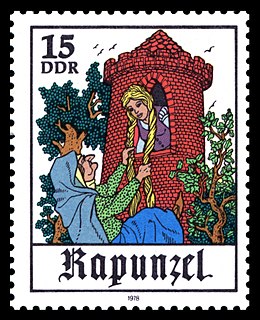
Rapunzel is a German fairy tale recorded by the Brothers Grimm and first published in 1812 as part of Children's and Household Tales. The Brothers Grimm's story developed from the French literary fairy tale of Persinette by Charlotte-Rose de Caumont de La Force (1698).

Ichabod Crane is a fictional character and the protagonist in Washington Irving's short story "The Legend of Sleepy Hollow." Crane is portrayed, in the original work, as well as most adaptations as a tall, lanky individual with a scarecrow effect. He is the local schoolmaster, and has a strong belief in all things supernatural, including the legend of the headless horseman. Crane eventually tries unsuccessfully to court the heiress Katrina Van Tassel, a decision which angers Abraham "Brom Bones" Van Brunt, a local man who also wishes to marry Katrina. After supposedly proposing to Katrina, Crane is headed home alone at night when the headless horseman appears and chases the schoolmaster until the horseman throws his pumpkin head at him causing him to mysteriously disappear without a trace.
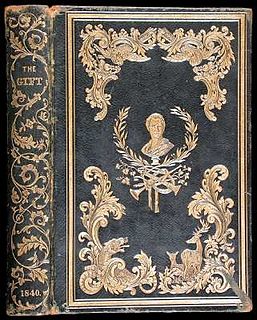
"William Wilson" is a short story by American writer Edgar Allan Poe, first published in 1839, with a setting inspired by Poe's formative years on the outskirts of London. The tale features a doppelgänger. It also appeared in the 1840 collection Tales of the Grotesque and Arabesque, and has been adapted several times.

1860s fashion in European and European-influenced countries is characterized by extremely full-skirted women's fashions relying on crinolines and hoops and the emergence of "alternative fashions" under the influence of the Artistic Dress movement.

1830s fashion in Western and Western-influenced fashion is characterized by an emphasis on breadth, initially at the shoulder and later in the hips, in contrast to the narrower silhouettes that had predominated between 1800 and 1820.

A deerstalker is a type of cap that is typically worn in rural areas, often for hunting, especially deer stalking. Because of the cap's popular association with the fictional detective Sherlock Holmes, it has become stereotypical headgear for a detective, especially in comical drawings or cartoons along with farcical plays and films.
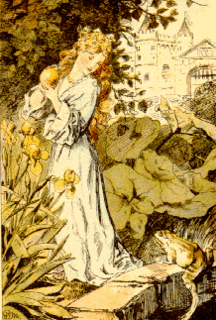
"The Frog Prince; or, Iron Henry" is a German fairy tale collected by the Brothers Grimm and published in 1812 in Grimm's Fairy Tales. Traditionally, it is the first story in their folktale collection. The tale is classified as Aarne-Thompson type 440.
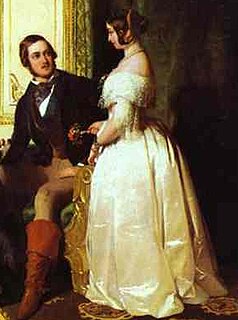
1840s fashion in European and European-influenced clothing is characterized by a narrow, natural shoulder line following the exaggerated puffed sleeves of the later 1820s and 1830s. The narrower shoulder was accompanied by a lower waistline for both men and women.
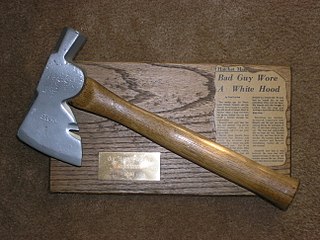
The Bunny Man is an urban legend that originated from two incidents in Fairfax County, Virginia, in 1970, but has been spread throughout the Washington, D.C., and Maryland areas. The legend has many variations; most involve a man wearing a rabbit costume who attacks people with an axe or hatchet.

Fashion in the period 1690–1740 in European and European-influenced countries is characterized by a widening silhouette for both men and women following the tall, narrow look of the 1680s and 90s. This era is defined as late Baroque/Rococo style. The new fashion trends introduced during this era had a greater impact on society, affecting not only royalty and aristocrats, but also middle and even lower classes. Clothing during this time can be characterized by soft pastels, light, airy, and asymmetrical designs, and playful styles. Wigs remained essential for men and women of substance, and were often white; natural hair was powdered to achieve the fashionable look. The costume of the eighteenth century, if lacking in the refinement and grace of earlier times, was distinctly quaint and picturesque.
Jenny Greenteeth a.k.a. Wicked Jenny or Ginny Greenteeth is a figure in English folklore. A river-hag, similar to Peg Powler or a grindylow, she would pull children or the elderly into the water and drown them. The name is also used to describe pondweed or duckweed, which can form a continuous mat over the surface of a small body of water, making it misleading and potentially treacherous, especially to unwary children. With this meaning the name is common around Liverpool and southwest Lancashire.

Fashion in the period 1500–1550 in Western Europe is marked by very thick, big and voluminous clothing worn in an abundance of layers. Contrasting fabrics, slashes, embroidery, applied trims, and other forms of surface ornamentation became prominent. The tall, narrow lines of the late Medieval period were replaced with a wide silhouette, conical for women with breadth at the hips and broadly square for men with width at the shoulders. Sleeves were a center of attention, and were puffed, slashed, cuffed, and turned back to reveal contrasting linings.

A White Lady is a type of female ghost. She has long straight hair, typically dressed in a white dress or similar garment, reportedly seen in rural areas and associated with local legends of tragedy. White Lady legends are found in many countries around the world. Common to many of these legends is an accidental death, murder, or suicide, and the theme of loss, betrayed by a husband or fiancé, and unrequited love.

Fashion in 15th-century Europe was characterized by a series of extremes and extravagances, from the voluminous robes called houppelandes with their sweeping floor-length sleeves to the revealing doublets and hose of Renaissance Italy. Hats, hoods, and other headdresses assumed increasing importance, and were draped, jewelled, and feathered.

Les Filles du feu is a collection of short prose works, poetry and a play published by the French poet Gérard de Nerval in January 1854, a year before his death. During 1853, Nerval had suffered three nervous breakdowns and spent five months in an asylum. He saw Les Filles du feu as an opportunity to show the public, his friends and his father that he was sane, though except for the introduction all of the pieces in Les Filles du feu had been published previously: "Angélique" in Les Faux Saulniers (1850), "Sylvie" in La Revue des Deux Mondes (1853), and "Émilie", "Jemmy", "Isis" and "Octavie" in diverse reviews.
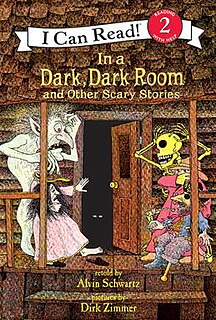
In a Dark, Dark Room and Other Scary Stories is a collection of horror stories, poems and urban legends retold for children by Alvin Schwartz and illustrator Dirk Zimmer. It was published as part of the I Can Read! series in 1984. The book contains seven works: "The Teeth", "In the Graveyard", "The Green Ribbon", "In a Dark, Dark Room", "The Night It Rained", "The Pirate", and "The Ghost of John".

The Headless Horseman is a mythical figure who has appeared in folklore around the world since the Middle Ages. The figure is traditionally depicted as a man upon horseback who is missing his head.
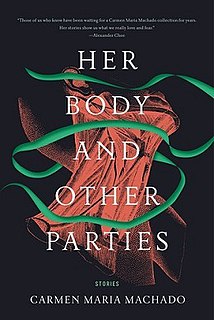
Her Body and Other Parties is a 2017 short story collection by the writer Carmen Maria Machado, published by Graywolf Press. The collection won the Shirley Jackson Award, and was a finalist for the National Book Award for Fiction. The story "The Husband Stitch" was nominated for the Nebula Award for Best Novelette.
References
- 1 2 3 4 5 "Story of the Week: The Adventure of the German Student". Library of America. March 25, 2016. Retrieved August 1, 2019.
- ↑ Crume & Schwarcz 1970, p. 2.
- ↑ Crume & Schwarcz 1970, p. 26–27.
- ↑ Crume & Schwarcz 1970, p. 2, 26–27.
- ↑ Peters, Lucia (August 16, 2016). "12 '90s Ghosts That Scared The Pants Off You". Bustle . Retrieved August 1, 2019.
- 1 2 Yapalater, Lauren (March 21, 2017). "For Everyone Who's Still Fucked Up Over That Story About The Girl With The Ribbon Around Her Neck". BuzzFeed . Retrieved August 1, 2019.
- ↑ Knight, Rosie (May 21, 2018). "The Urban Legends That Inspired SCARY STORIES TO TELL IN THE DARK". Nerdist . Retrieved August 1, 2019.
Sources
- Crume, Vic; Schwarcz, Gladys, eds. (1970). The Haunted House and Other Spooky Poems and Tales. Internet Archive: Scholastic Book Services. ISBN 978-0590092197.